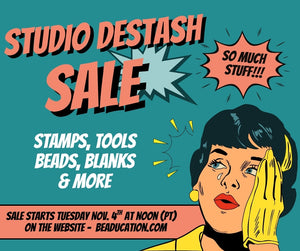How Much Should I Charge for My Jewelry on Etsy?
When users join Etsy, they are excited to be able to share their creations with the world. Their relative inexperience and desire to make a name for themselves may cause chronic under pricing, a problem that sadly goes uncorrected far too often. You may lose motivation if you do not make enough profit per sale. If you're wondering "how much should I sell my jewelry for?" you have come to the right place! Below you will find pricing guidelines as well as the reasoning behind them.
The first step is to charge what an item is worth, not what you think customers would be willing to pay.
Your item's price sends a message to your consumer about its quality, so a lower price can actually turn off some shoppers looking for high quality merchandise. As a result, you should never look to undersell other Etsy sellers. Worse still, chronic undercharging can give customers a false sense of what they should expect to pay for a quality item, hurting all of the sellers in your niche, not just you.
Perhaps you are hesitant to charge more because you fear alienating the customer base you already have. Chances are you have nothing to worry about. To prove it, try an experiment by introducing a new line of merchandise at a higher price point while maintaining your old price points on older items. The new probably sells at least as well as the old. Quality merchandise will sell even if it is a few more dollars than it used to be.
Once you've made up your mind to charge a fair price, you need to go about it the right way. The easiest method is to identify a few other sellers who offer similar products to you and then charge the average of what they charge. You could still end up too low if they are not charging what they should be, however, so this method is not foolproof.
If you need a foolproof method, crunch the numbers yourself. Don't worry, you won't need complicated math. What you will need is a wholesale price. The wholesale price is what a customer pays when they buy from you directly. First, determine what your hourly rate is. That will be part of if not all of your labor cost. The following formula will help you set a fair wholesale price:
(Labor + Materials) x 2 = Wholesale price
The labor cost should be how much money you want to make per hour (or month), divided by how many items you can produce in that hour (or month). For example, if you can make four of the same items per hour and want to make $50/hr, the labor cost can be $12.50 per item. Your time is valuable, so it is a mistake not to pay yourself something for the time spent making an item.
Material costs are fairly self-explanatory, and doubling the cost ensures that you make a profit after covering any additional overhead costs. Look for options to buy in bulk for items you know you can use for more than one style of jewelry. While it's great to get a better price, be sure not to overbuy on items that are not as versatile.
Should a retailer express an interest in carrying your wares, a whole new model emerges. Retailers need to mark your wholesale price up in order to make a worthwhile profit for themselves, and it is your job to provide them with an MSRP. The formula below will help you do so:
Wholesale Price x 2 = MSRP
While it is somewhat counter intuitive to think you can raise prices without losing sales, it is a common occurrence on Etsy. Customers want premium products and will not even consider items priced too cheaply. You may also find it difficult to keep producing products if the rewards are not satisfactory. Thankfully, the tips above should help you determine prices fair for everyone!
Have any tips you would like to add or any questions we can help with? Enter in the comments below.
The first step is to charge what an item is worth, not what you think customers would be willing to pay.
Your item's price sends a message to your consumer about its quality, so a lower price can actually turn off some shoppers looking for high quality merchandise. As a result, you should never look to undersell other Etsy sellers. Worse still, chronic undercharging can give customers a false sense of what they should expect to pay for a quality item, hurting all of the sellers in your niche, not just you.
Perhaps you are hesitant to charge more because you fear alienating the customer base you already have. Chances are you have nothing to worry about. To prove it, try an experiment by introducing a new line of merchandise at a higher price point while maintaining your old price points on older items. The new probably sells at least as well as the old. Quality merchandise will sell even if it is a few more dollars than it used to be.
Once you've made up your mind to charge a fair price, you need to go about it the right way. The easiest method is to identify a few other sellers who offer similar products to you and then charge the average of what they charge. You could still end up too low if they are not charging what they should be, however, so this method is not foolproof.
If you need a foolproof method, crunch the numbers yourself. Don't worry, you won't need complicated math. What you will need is a wholesale price. The wholesale price is what a customer pays when they buy from you directly. First, determine what your hourly rate is. That will be part of if not all of your labor cost. The following formula will help you set a fair wholesale price:
(Labor + Materials) x 2 = Wholesale price
The labor cost should be how much money you want to make per hour (or month), divided by how many items you can produce in that hour (or month). For example, if you can make four of the same items per hour and want to make $50/hr, the labor cost can be $12.50 per item. Your time is valuable, so it is a mistake not to pay yourself something for the time spent making an item.
Material costs are fairly self-explanatory, and doubling the cost ensures that you make a profit after covering any additional overhead costs. Look for options to buy in bulk for items you know you can use for more than one style of jewelry. While it's great to get a better price, be sure not to overbuy on items that are not as versatile.
Should a retailer express an interest in carrying your wares, a whole new model emerges. Retailers need to mark your wholesale price up in order to make a worthwhile profit for themselves, and it is your job to provide them with an MSRP. The formula below will help you do so:
Wholesale Price x 2 = MSRP
While it is somewhat counter intuitive to think you can raise prices without losing sales, it is a common occurrence on Etsy. Customers want premium products and will not even consider items priced too cheaply. You may also find it difficult to keep producing products if the rewards are not satisfactory. Thankfully, the tips above should help you determine prices fair for everyone!
Have any tips you would like to add or any questions we can help with? Enter in the comments below.
- Lisa Kelly





